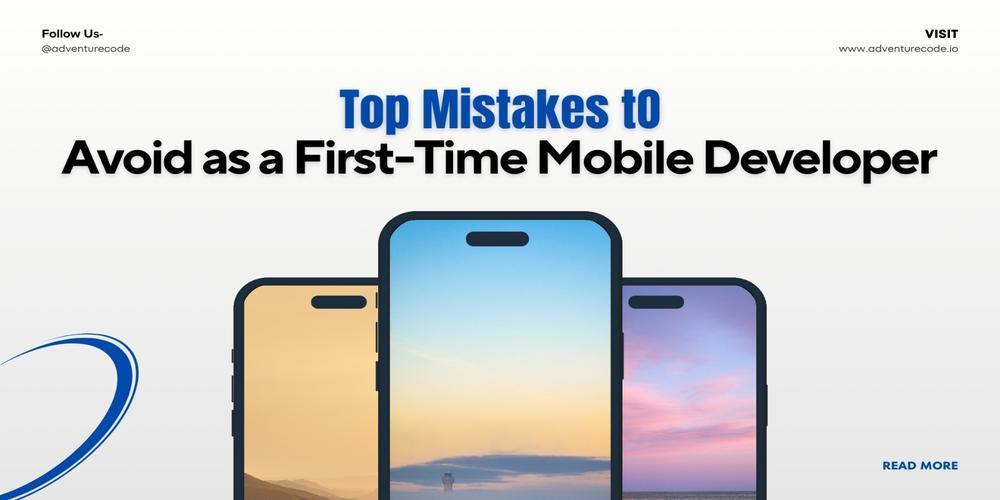Starting a career in mobile app development for beginners is both exciting and challenging. The joy of creating your first app and watching your vision come to life is extremely satisfying, but it's also simple to slip into first-time mobile developer mistakes, particularly for beginners. Many inexperienced developers underestimate the importance of understanding platform-specific requirements, which leads to inefficient code, errors, and underperforming apps. Whether developing Android or iOS apps or working with a cross-platform framework, a lack of understanding or neglecting critical phases can result in painful setbacks and a poor user experience.
Being aware of potential problems from the start can significantly impact your app's quality and performance. Common mobile development errors such as violating user interface principles, skipping real-device testing, or overcomplicating the codebase can stall or derail projects entirely. In this post, we'll look at six common mistakes that beginner mobile developers make and offer guidance on how to prevent them using mobile development best practices. This will help you start building smooth, responsive, and successful applications right from the beginning.
1. Ignoring User Experience and Interface Design
Many beginner mobile developers concentrate heavily on coding features while neglecting how users interact with the app. Even if the program provides proper functionality, poor design decisions—like cluttered layouts, inconsistent elements, or confusing navigation—can quickly drive users away. First impressions are essential, and ignoring UI/UX in mobile apps can lead to low retention or even quick uninstalls.
To avoid this, developers should make UI/UX design a central part of their development process. Conduct usability testing early and often, follow platform-specific design rules such as Material Design for Android or Human Interface Guidelines for iOS, and pay attention to real user feedback. These steps ensure your app is not just functional but also engaging and user-friendly.
2. Adding Too Many Features to the App
Adding Too Many Features to the App is a classic first-time mobile developer mistake. While the goal is often to impress users, this can overwhelm the interface, slow down performance, and complicate maintenance. Feature overload also distracts users from the app’s main purpose, leading to confusion and frustration.
A better strategy is to develop a Minimum Viable Product (MVP)—a simpler version of your app that delivers its core value. This approach supports faster development, easier debugging, and allows users to provide targeted feedback. Based on their input, you can prioritize which additional features to develop in later stages.
3. Not Testing Across Devices and Platforms
Many mobile app development for beginners mistakes arise from assuming that if an app works on the developer’s phone, it will work everywhere. But real-world users have different phones, screen sizes, operating system versions, and network conditions. Failing to test on multiple devices can lead to crashes, display issues, and broken functionality.
To address this, follow mobile app testing best practices. Use emulators during early development, but always conduct real-device testing before release. Tools like Firebase Test Lab allow you to test your app on a variety of real-world devices, ensuring broader compatibility and a smoother user experience.
4. Failing to Follow Platform Guidelines
A major common mobile development error is ignoring platform-specific design and technical guidelines. iOS and Android have unique navigation styles, gestures, and user expectations. Trying to build a universal app without considering these differences results in a clunky, non-native experience that users may find confusing or unattractive.
The solution lies in adopting mobile development best practices for each platform. Study Apple’s Human Interface Guidelines for iOS and Google’s Material Design principles for Android. Adapting your app to these standards enhances usability, performance, and increases your chances of getting featured in app stores. Native-feeling apps also tend to enjoy better user retention and satisfaction.
5. Ignoring Performance Optimization
Beginners often underestimate the importance of performance optimization in mobile apps. A visually beautiful app loaded with features won't matter if it lags, drains the battery, or takes too long to load. Mobile users anticipate apps that are quick, responsive, and efficient.
To avoid performance issues, optimize assets such as images, reduce unnecessary background processes, and minimize heavy network requests. Use tools like Android Profiler and Instruments in Xcode to monitor performance during development. By prioritizing performance optimization in mobile apps, you ensure that users have a positive and frictionless experience, which is critical for app success and retention.
6. Ignoring Code Maintenance and Documentation
When rushing to meet deadlines or launch an app, developers often overlook code maintenance in mobile apps. Writing messy or undocumented code may work short term, but it quickly becomes a liability. Whether you’re working alone or with a team, unclear code makes debugging, updates, and scaling far more difficult.
To prevent this, write clean, modular, and well-organized code. Use consistent naming conventions, document your code with clear comments, and maintain a README file or changelog. Practicing good code maintenance in mobile apps makes your project more manageable, easier to collaborate on, and more future-proof.
Conclusion
Becoming a mobile developer is a rewarding journey, but it requires more than just coding skills. By avoiding first-time mobile developer mistakes like poor design, lack of testing, and unoptimized performance, you can set yourself apart and build successful apps. Implementing mobile development best practices, focusing on UI/UX in mobile apps, adhering to mobile app testing best practices, and maintaining a clean codebase are essential steps for long-term success. Start simple, stay consistent, and keep learning your first app could be the foundation of a thriving development career.






